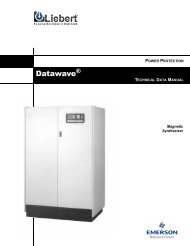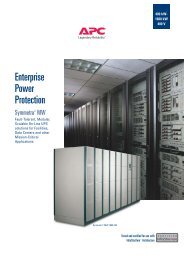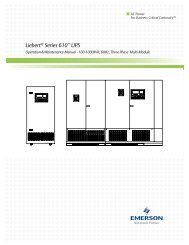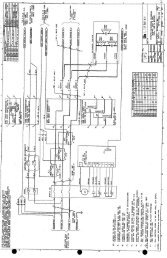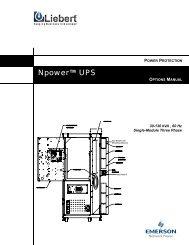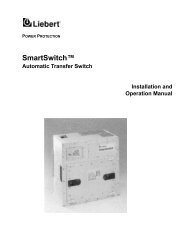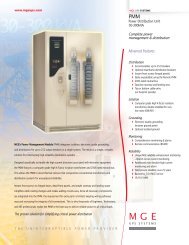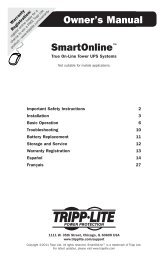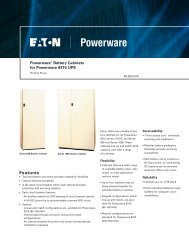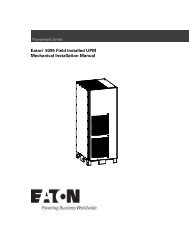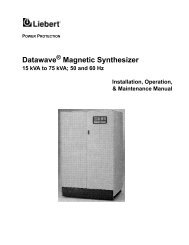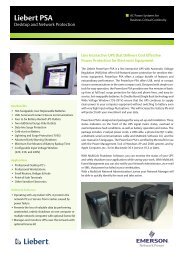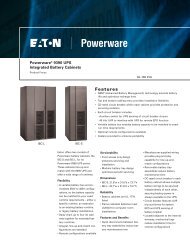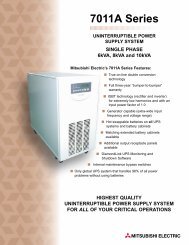Guide Specification; 50/60Hz (R10/07) (SL-20209) - Emerson ...
Guide Specification; 50/60Hz (R10/07) (SL-20209) - Emerson ...
Guide Specification; 50/60Hz (R10/07) (SL-20209) - Emerson ...
You also want an ePaper? Increase the reach of your titles
YUMPU automatically turns print PDFs into web optimized ePapers that Google loves.
1.1 SUMMARY<br />
Liebert Datawave<br />
GUIDE SPECIFICATIONS<br />
100 - 200 kVA Magnetic Synthesizer<br />
Power Conditioning System<br />
1.0 GENERAL<br />
These specifications describe requirements for a complete power conditioning and distribution system,<br />
supplying computer-grade power to sensitive loads. The specified system shall provide isolation,<br />
regulation, noise and transient suppression, distribution, control and monitoring of AC power. It shall<br />
include all equipment to properly interface the AC power source to the intended load.<br />
1.2 STANDARDS<br />
The specified system shall be designed, manufactured, tested and installed in compliance with:<br />
• American National Standards Institute (ANSI)<br />
• Canadian Standards Association (CSA)<br />
• Institute of Electrical and Electronics Engineers (IEEE)<br />
• International Standards Organization Quality Standard ISO 9001<br />
• National Electrical Code (NEC - NFPA 70)<br />
• National Electrical Manufacturers Association (NEMA)<br />
• National Fire Protection Association (NFPA 75)<br />
• Underwriters Laboratories (UL)<br />
The system shall be UL-listed as a complete system under UL 609<strong>50</strong> Standard for Information<br />
Technology Equipment (UL listing applies to 60 Hz units only). <strong>50</strong> Hz units shall comply with EN and<br />
the European Low Voltage Directive and be CE marked.<br />
The specified system shall comply with the latest FCC Part 15 EMI emission limits for Class A<br />
computing devices and the emission and immunity limits of EN<strong>50</strong>081-2/EN5<strong>50</strong>022 Class A and<br />
EN<strong>50</strong>082-2.<br />
The unit shall safely withstand the following conditions without misoperation or damage:<br />
• Transient voltage surges on the AC power input as defined by ANSI/IEEE C62.41 for Category<br />
B3 locations (high surge exposure industrial and commercial facilities).<br />
• Electrostatic discharges (ESD) up to 10 kV at any point on the exterior of the unit.<br />
• Electromagnetic fields from portable transmitters within 3 ft. (1m) of the unit.<br />
1.3 SYSTEM DESCRIPTION<br />
1.3.1 Electrical Requirements<br />
Output capacity shall be [(100) (125) (1<strong>50</strong>) (200)] kVA.<br />
Input voltage shall be [(600) (480) (415) (400) (380) (240) (208) (____)] volts AC, [(60) (<strong>50</strong>)] Hz, threephase,<br />
three-wire-plus-ground.<br />
Output voltage shall be [(208/120) (380/220) (400/230) (415/240) (480/277) (600/346) (____)] volts AC,<br />
[(60) (<strong>50</strong>)] Hz, three-phase, four-wire-plus-ground, wye configuration.<br />
<strong>SL</strong>-<strong>20209</strong>_REV01_10-<strong>07</strong> 1 <strong>Guide</strong> <strong>Specification</strong>s
1.3.2<br />
1.4.1<br />
1.4.2<br />
1.4.3<br />
1.4.4<br />
Environmental Requirements<br />
Liebert Datawave<br />
A. Storage Temperatures. The storage temperature range shall be -67° to +185°F (-55° to +85°C).<br />
B. Operating Temperatures. The storage temperature range shall be 32° to 104°F (0° to 40°C).<br />
C. Relative Humidity. Operation shall be reliable in an environment with 0% to 95% noncondensing<br />
relative humidity.<br />
D. Audible Noise. The audible noise level of the specified system shall be less than 63 dBA at 5 ft.<br />
(1.5m).<br />
1.4 DOCUMENTATION<br />
Equipment Manual<br />
The manufacturer shall furnish an installation manual with installation, startup, operation and<br />
maintenance instructions for the specified system.<br />
Drawings<br />
Wiring diagrams and drawings of major components shall be furnished.<br />
Spare Parts<br />
A list of recommended spare parts shall be supplied at the customer’s request.<br />
User’s List<br />
An in-service user’s list shall be furnished upon request.<br />
1.5 WARRANTY<br />
The manufacturer shall provide a one-year warranty against defects in material and workmanship for 12<br />
months after initial startup or 18 months after ship date, whichever occurs first (refer to the Warranty<br />
Statement for details).<br />
1.6 QUALITY ASSURANCE<br />
The specified system shall be factory-tested before shipment. Testing shall include, but shall not be<br />
limited to: Quality Control Checks, Hi-Pot Test (two times rated voltage plus 1000 volts, per UL<br />
requirements), Full Load Tests and Metering Calibration Tests. The system shall be designed and<br />
manufactured according to world class quality standards. The manufacturer shall be ISO 9001 certified.<br />
<strong>SL</strong>-<strong>20209</strong>_REV01_10-<strong>07</strong> 2 <strong>Guide</strong> <strong>Specification</strong>s
2.1 COMPONENTS<br />
2.0 PRODUCT<br />
Liebert Datawave<br />
2.1.1 Frame Construction and Enclosure<br />
The frame shall be constructed of welded steel to provide a strong substructure and ensure grounding<br />
integrity. The enclosure shall be designed with a welded steel base so that the unit can be moved by forklift<br />
equipment and set flat on the floor without the use of a floorstand. All service and system operation<br />
shall be capable of being performed with access to the front and right side. A tool shall be required to<br />
remove the exterior panels that access the hazardous voltage area of the unit. For grounding integrity,<br />
static protection and EMI shielding, outer panels shall be grounded to the frame with copper wire. Hinged<br />
lockable doors shall provide access for operation of the main input circuit breaker and output circuit<br />
breaker(s). Exterior panel color shall be [(manufacturer’s standard color) (________)].<br />
(Units 1<strong>50</strong>kVA and larger) The system shall be designed in a split (2) module system. The split-module<br />
system shall allow the two modules to be separated for shipping (to minimize handling difficulties), for<br />
reconnection at the installation site. All of the necessary wiring and hardware for interconnecting of the<br />
two units shall be factory-supplied.<br />
The complete specified system shall have maximum dimensions of: Width, 66 in. (1676mm) [100-125<br />
kVA systems], 104 in. (2642mm) [1<strong>50</strong>-200 kVA systems]; Depth, 36 in. (914mm); Height, 76 in.<br />
(1930mm). Exterior panels shall be removable to allow the unit to fit through a 34-inch (864mm)<br />
doorway. The distributed floor weight shall be a maximum of 300 lbs/sq. ft. (1465 kg/sq. m). Multiple<br />
redundant cooling fans (n + 1) shall allow continuous full load operation at the maximum specified<br />
temperature without overtemperature.<br />
2.1.2 Input Connections<br />
2.1.2.1 Power<br />
Terminals shall be provided for the incoming AC power and ground. The power connections shall be<br />
designed to accept wire sizes commensurate with the input circuit breaker:<br />
125 - 2<strong>50</strong> A #8 - 3<strong>50</strong> kcmil<br />
300 - 600 A (2) #2/0 - 400 kcmil<br />
700 - 800 A (3) 2<strong>50</strong> - <strong>50</strong>0 kcmil<br />
2.1.2.2 Control<br />
The low-voltage control input shall contain a terminal block with at least 21 positions for connecting all<br />
building interface alarms, controls, centralized monitoring and Remote Emergency Power Off (REPO)<br />
switches. The low-voltage control section shall also contain a 24 VDC, DPDT building interface relay for<br />
interfacing with environmental systems, alarm panels, etc. The relay contacts shall be rated for use at up<br />
to 10 amps at 240 VAC.<br />
2.1.3 Main Input Circuit Breaker<br />
The specified unit shall be equipped with a main input circuit breaker to provide overcurrent protection<br />
and a means for disconnecting power to the unit. The main input circuit breaker shall be a three-pole<br />
molded case circuit breaker sized for at least 125% of the specified full load input current and rated for<br />
600 VAC. The minimum UL-listed interrupting rating for the main input circuit breaker shall be [(25,000)<br />
( )] RMS symmetrical amperes at 480 volts AC. The main input circuit breaker shall include a 24<br />
VDC shunt trip mechanism to interface with EPO switches and other system controls.<br />
2.1.4 Magnetic Synthesizer<br />
Power conditioning shall be accomplished by using a magnetic synthesizer. The magnetic synthesizer<br />
shall be a static electromagnetic 3-phase AC power regenerator and shall not contain mechanically<br />
moving parts, power semi-conductors or feedback control circuits.<br />
2.1.4.1 Function<br />
The magnetic synthesizer shall accept 3-phase 3-wire (delta configuration) input power and shall<br />
regenerate (synthesize) clean 3-phase 4-wire (wye configuration) output power. The synthesizer shall be a<br />
true 3-phase device which maintains the output voltage phase separation at 120 electrical degrees under<br />
<strong>SL</strong>-<strong>20209</strong>_REV01_10-<strong>07</strong> 3 <strong>Guide</strong> <strong>Specification</strong>s
Liebert Datawave<br />
any load conditions. The sine wave output voltage shall be synthesized from six saturating transformer<br />
pulses for each half-cycle.<br />
2.1.4.2 Transformers<br />
All transformers shall be UL-recognized, dry type transformers, with UL class 200 insulation and all<br />
copper windings. All pulse transformers shall have two electrostatic shields for noise isolation.<br />
2.1.4.3 Capacitors<br />
The capacitors shall be metalized polypropylene capacitors for high reliability. The capacitors shall<br />
exhibit self-healing characteristics and shall be equipped with an integral, UL-recognized, pressuresensitive<br />
interrupter. The interrupter shall provide short circuit current interrupting capability up to 10,000<br />
amperes at 600 VAC. The capacitors shall be wired in a multi-redundant configuration so that individual<br />
capacitor failures will have a minimal impact on the operation of the magnetic synthesizer.<br />
2.1.4.4 Performance Characteristics<br />
The following shall be typical characteristics exhibited by the magnetic synthesizer.<br />
A. Static Voltage Regulation (for any load condition, no load to full load): For nominal input voltage,<br />
the output voltage shall be within nominal to ±3%. For input voltage variation of +40% to -40% of<br />
nominal, the output voltage shall be within +5% to -5%.<br />
B. Unbalanced Load: At nominal input voltage and with 100% load imbalance, output voltage shall be<br />
within +5% and -2%.<br />
C. Overload: At nominal input voltage, while increasing the load from full load to 200% of full load,<br />
the output voltage shall be no less than -6% of nominal. The unit shall be capable of sustaining 200%<br />
load until activation of the overcurrent protection, typically 3 to 20 minutes.<br />
D. Input Transients: No power disturbances shall be evident on the output when high-energy ringing<br />
transients are impressed on the input lines. The specified system shall protect against surges as<br />
defined by ANSI/IEEE Standards C62.41 and C62.45.<br />
E. Electrical Noise Suppression: Common mode noise suppression shall be 120 dB minimum. Normal<br />
mode noise suppression shall be 120 dB minimum.<br />
F. Unbalanced Input Voltage (Single-Phasing): Upon loss of one phase of input voltage, output phase<br />
voltages shall remain within +5.8% to -4% of nominal from no load to 60% load.<br />
G. Short-Circuit Capability: The sustained short-circuit current shall be limited to 300% of full load.<br />
This current output shall be sustained without damage, until the overcurrent protection is activated.<br />
H. Harmonic Distortion (No load to full load): The output voltage total harmonic distortion shall be<br />
less than 4%. Input voltage distortion shall not be added to the output voltage distortion.<br />
I. Efficiency: At nominal input voltage, the efficiency of the system shall be:<br />
93% at full load.<br />
91.5% at three-quarter load.<br />
89% at half load.<br />
J. Input Power Factor: The input power factor of the magnetic synthesizer shall be nearly unity under<br />
all load conditions from half to full load. The full load input power factor shall be 0.96 lagging, or<br />
better. The input power factor shall be independent of the load power factor.<br />
K. Input Current: The magnetic synthesizer shall draw linear input current from no load to full load.<br />
Input current distortion shall be less than 8% THD, independent of output current distortion.<br />
L. Output Impedance: A 3-phase bank of capacitors shall be directly connected across the output of the<br />
magnetic synthesizer for low output impedance. The output capacitance shall attenuate load generated<br />
noise and transients, as well as supply the non-linear current requirements of modern computer<br />
equipment without causing excessive output voltage distortion.<br />
<strong>SL</strong>-<strong>20209</strong>_REV01_10-<strong>07</strong> 4 <strong>Guide</strong> <strong>Specification</strong>s
2.1.4.5 Thermal Overload<br />
Liebert Datawave<br />
The magnetic synthesizer shall be provided with additional thermal overload protection for the<br />
transformers. An alarm shall sound if any transformer temperature reaches 320°F (160°C). The system<br />
shall automatically shut down if any transformer temperature reaches 356°F (180°C).<br />
2.1.4.6 Paralleling Capability<br />
The magnetic synthesizer shall be capable of being paralleled with like units of the same or different<br />
capacity to make larger kVA systems or parallel redundant systems. Paralleling shall be accomplished<br />
with minimal circulating current and without the use of control circuitry for load sharing.<br />
2.1.5<br />
2.1.6<br />
Manual Restart<br />
A manual restart circuit shall allow for an orderly supervised startup after power failure. The control<br />
circuit shall automatically energize the shunt trip mechanism of the main input breaker upon sensing<br />
output voltage failure. A field-selectable auto-restart mode shall be provided to deactivate the manual<br />
restart if desired.<br />
Emergency Power Off (EPO)<br />
The local EPO shall include a fully guarded and illuminated EMERGENCY POWER OFF pushbutton.<br />
Pressing the EPO switch shall immediately shut down the system by activating the shunt trip of the main<br />
input circuit breaker. As part of the EPO circuit, an interface shall also be provided for connecting<br />
normally open or normally closed remote EPO switches to the EPO circuit. For flexibility in meeting<br />
shutdown control schemes, the local EPO (unit shutdown) circuit shall be isolated from the remote EPO<br />
(room shutdown) circuit. The remote EPO circuit shall be designed to allow direct connection of multiple<br />
units with single and/or multiple shutdown control contacts.<br />
2.1.7 Computer-Grade Ground<br />
A computer-grade, single-point ground shall be provided in accordance with the computer manufacturer’s<br />
recommendations, IEEE Std. 1100 and the requirements of the NEC. The synthesizer output neutral shall<br />
be solidly grounded in accordance with NEC article 2<strong>50</strong>-26.<br />
2.2 CONDITIONING-ALONE SYSTEM<br />
[NOTE: Select either a Conditioning-Alone system (conditioning only) or a Self-Contained system<br />
(conditioning plus power distribution).]<br />
The Conditioning-Alone System shall also include:<br />
2.2.1 Main Output Breaker<br />
The specified unit shall have a main output circuit breaker for overcurrent protection and a system<br />
disconnecting means. It shall be sized for 125% of the specified system full load output current in<br />
accordance with the NEC. The minimum UL-listed interrupting rating for the main output circuit breaker<br />
shall be 10,000 RMS symmetrical amperes at rated output voltage.<br />
2.2.2 Output Power Connections<br />
The specified unit shall contain five terminals for connection of the output AC power. The three output<br />
phase connections shall be to lugs mounted on the load side of the main output circuit breaker. The<br />
neutral and ground connections shall be power terminals. All output power terminals shall be designed to<br />
accept wire sizes commensurate with the circuit breaker rating, double-sized neutral and parity-sized<br />
ground conductors.<br />
<strong>SL</strong>-<strong>20209</strong>_REV01_10-<strong>07</strong> 5 <strong>Guide</strong> <strong>Specification</strong>s
2.3 SELF-CONTAINED SYSTEM<br />
Liebert Datawave<br />
[NOTE: Select either a Conditioning-Alone system (conditioning only) or a Self-Contained system<br />
(conditioning plus power distribution).]<br />
The Self-Contained System shall also include:<br />
2.3.1<br />
Output Distribution Panelboards<br />
The specified system shall contain four vertically mounted 42-pole, 3-phase panelboards for distribution<br />
to the intended loads. Each distribution panelboard shall be individually protected by a main panelboard<br />
circuit breaker. Each panelboard shall be individually enclosed with a separate cover which provides<br />
access to that panelboard without exposing other portions of the unit. The panelboard shall have a rating<br />
of 225 amperes, with an overall short-circuit current rating of 10,000 RMS symmetrical amperes. The<br />
panelboards shall provide a total of 120 single-pole branch circuit breaker positions. Each panelboard<br />
shall include separate isolated neutral and safety-ground bus bars for the neutral and safety-ground<br />
connections for at least 42 output circuits. Each neutral bus bar and wiring shall be rated for at least 1.73<br />
times the full load rating of the panelboard to accommodate high neutral currents associated with<br />
single-phase nonlinear loads.<br />
2.3.2 Branch Circuit Breakers<br />
Each load shall be protected by an individual branch circuit breaker as shown on the plans. Each branch<br />
circuit breaker shall provide overcurrent protection and ON-OFF switching to the specified load. Singlepole,<br />
two-pole and three-pole [(plug-in) (bolt-in)] type branch circuit breakers up through 100 amperes<br />
shall be utilized. Each circuit breaker shall clearly indicate the ON, OFF and TRIPPED positions. All<br />
branch circuit breakers shall have a minimum interrupting capacity of 10,000 RMS symmetrical amperes<br />
at 120/240 VAC. Each branch circuit breaker shall be sized in accordance with the NEC and shall be<br />
UL/CSA listed. Branch circuit breakers shall have an associated directory label, located adjacent to the<br />
breaker, identifying the branch circuit number and the equipment being served.<br />
2.3.3 Output Distribution Cables<br />
The cable supplying each load shall consist of UL/CSA listed liquid-tight flexible metal conduit<br />
containing the required THHN copper-insulated power, neutral and parity-sized ground conductors. The<br />
flexible conduit shall be liquid-tight, insulated and shielded to minimize electrical or mechanical<br />
disturbances to the conductors. The length of each cable and the type of receptacle or termination shall be<br />
as specified on the detailed cable schedule. Each output distribution cable shall be permanently labeled at<br />
each end of the cable with the assigned circuit number and receptacle type, equipment identification and<br />
cable length. Each cable shall be thoroughly factory-checked and factory-tested. Tests shall include<br />
continuity, phase rotation and a Hi-Pot test at twice the rated circuit voltage plus 1000 volts. All output<br />
cables shall be wound on spools mounted on casters to facilitate handling and installation. Each cable<br />
shall be individually UL-listed and labeled.<br />
2.4 BASIC MONITORING SYSTEM<br />
[NOTE: Select either a Basic Monitoring system or a Power Monitoring system.]<br />
The basic monitoring system shall have transformer overtemperature and Emergency Power Off (EPO)<br />
circuits. All indicators and controls shall be on the front door, along with identifying system number.<br />
The transformer overtemperature circuit shall include an audible and visual alarm if internal transformer<br />
winding temperature reaches 320°F (160°C). A SILENCE switch shall be provided to silence the audible<br />
alarm. The transformer overtemperature circuit shall also trip the main input breaker to remove power<br />
automatically when any transformer winding temperature reaches 356°F (180°C).<br />
<strong>SL</strong>-<strong>20209</strong>_REV01_10-<strong>07</strong> 6 <strong>Guide</strong> <strong>Specification</strong>s
2.5 POWER MONITORING SYSTEM<br />
[NOTE: Select either a Basic Monitoring system or a Power Monitoring system.]<br />
Liebert Datawave<br />
The specified system shall be equipped with a microprocessor-based Power Monitor Panel. The monitor<br />
panel shall gather and process information from electrical and environmental sensors, relays and switches<br />
both internal and external to the unit. The monitored parameters and alarms shall be displayed on the unit<br />
monitor panel and shall also be available for communication to a Liebert centralized site monitoring<br />
system using a two-wire, twisted-pair, low-voltage signal circuit having an RS-422 format for reliable<br />
communication up to 1000 meters. Additionally, the monitor panel shall be equipped with an RS-232<br />
service port for adjusting parameters and performing diagnostics.<br />
2.5.1<br />
2.5.2<br />
Monitored Parameters<br />
The monitoring system shall monitor and display all of the following parameters:<br />
• Input Voltages, Line-to-Line for all three phases<br />
• Output Voltages, Line-to-Line for all three phases<br />
• Output Voltages, Line-to-Neutral for all three phases<br />
• Output Current for all three phases<br />
• Output Neutral Current<br />
• System Ground Current<br />
• Output Frequency<br />
• Output kVA<br />
• Output kW<br />
• Output Power Factor<br />
• Percent Load<br />
All three phases of the three-phase parameters shall be displayed simultaneously. All voltage and current<br />
parameters shall be monitored using true RMS measurements for accurate representation of nonsinusoidal<br />
waveforms typical of computers and other sensitive loads.<br />
Alarm Annunciation<br />
The monitoring system shall detect and annunciate by audible alarm and displayed alarm message the<br />
following conditions:<br />
• Output Overvoltage<br />
• Output Undervoltage<br />
• Output Overload<br />
• Neutral Overcurrent<br />
• Ground Overcurrent<br />
• Transformer Overtemperature<br />
• Frequency Deviation<br />
• Phase Sequence Error<br />
• Phase Loss<br />
All alarm thresholds for monitored parameters shall be adjustable by way of the service port to match site<br />
requirements. The factory setpoints for the alarms shall be as follows:<br />
• Output Overvoltage Output voltage exceeds +6% of nominal<br />
• Output Undervoltage Output voltage falls below -13% of nominal<br />
• Output Overload Output current exceeds 95% of full load amps<br />
• Neutral Overcurrent Neutral current exceeds 95% of full load amps<br />
• Ground Overcurrent Ground current exceeds 5 amps<br />
• Frequency Deviation Output frequency exceeds ±0.5 Hz of nominal<br />
<strong>SL</strong>-<strong>20209</strong>_REV01_10-<strong>07</strong> 7 <strong>Guide</strong> <strong>Specification</strong>s
Liebert Datawave<br />
To facilitate troubleshooting, all alarms shall be stored in battery-backed (non-volatile) memory until reset<br />
to protect against erasure by a power outage. Alarms shall be able to be manually reset, either at the unit<br />
or through the centralized site monitoring system, after the alarm condition has been corrected.<br />
2.5.3<br />
Custom Alarm Annunciation<br />
The monitoring system shall be capable of providing alarm annunciation for up to five contact closures (4<br />
N.O., 1 N.C.). A custom alarm message of up to 20 characters shall be provided for each contact. Alarm<br />
messages shall be programmable by way of the service port to match site requirements.<br />
2.5.4 Summary Alarm Contact<br />
A Form C (1 N.O., 1 N.C.) Summary Alarm Contact shall be provided for remote alarm status. The<br />
contacts shall change state upon occurrence of any alarm and shall reset upon alarm silence.<br />
2.5.5 Display<br />
All monitored parameters and alarm messages shall be displayed on a 4 x 20 character, high visibility<br />
liquid crystal display (LCD) located on the unit front door within a decorative bezel. Included in the bezel<br />
shall be an Identifying Unit Number, Emergency Power Off (EPO) switch and an Alarm Present/Silence<br />
switch.<br />
The Alarm Present/Silence switch shall be illuminated upon occurrence of any alarm and remain<br />
illuminated until all alarms are reset. The switch shall also be used to silence the audible alarm and reset<br />
inactive alarms.<br />
2.5.6 Autoscan<br />
For ease of operation, the monitoring system shall include an autoscan mode which provides continuous<br />
sequential display of all monitored parameters and active alarm messages. A Hold/Sequence switch shall<br />
be provided to interrupt the autoscan mode and allow manual selection of the displayed parameters.<br />
<strong>SL</strong>-<strong>20209</strong>_REV01_10-<strong>07</strong> 8 <strong>Guide</strong> <strong>Specification</strong>s
Liebert Datawave<br />
2.6 ACCESSORIES (OPTIONAL COMPONENTS)<br />
2.6.1<br />
Main Input Junction Box<br />
A junction box shall be provided for the main input power connections. The junction box shall contain<br />
terminal blocks for connection of the incoming AC power conductors and a parity-sized ground<br />
conductor. To allow installation under a standard raised floor system, the junction box shall have<br />
maximum dimensions of: Width, 16 in. (406mm); Length, 30 in. (762mm); Height, 6 in. (152mm). A<br />
main input cable assembly shall be provided for connection to the unit at installation. The cable shall be<br />
10 feet (3m) long and consist of 194°F (90°C) copper conductors inside a UL/CSA listed liquid-tight,<br />
flexible metal conduit, sized in accordance with the NEC, based on the main input circuit breaker rating.<br />
For reliability and per NEC, no plug and receptacle connectors shall be used for the main input cable.<br />
2.6.2 Transient Suppression Plate<br />
The specified system shall have a transient suppression plate for the main input junction box to reduce<br />
effects of transients on the ground. The suppression plate shall measure one square meter.<br />
2.6.3 Low-Voltage Junction Box<br />
A separate watertight low-voltage junction box shall be provided to isolate low-voltage connections from<br />
main input connections. The low-voltage junction box shall contain a terminal block with at least twentyone<br />
positions for connecting all building interface alarms and controls, centralized site monitoring<br />
communication circuits and all Remote Emergency Power Off (REPO) switches. The low-voltage<br />
junction box shall also contain a 24 VDC, DPDT building interface relay for interfacing with<br />
environmental systems, alarm panels, etc. The relay contacts shall be rated for use up to 10 amps at 240<br />
VAC. To allow installation under a standard raised floor system, the junction box shall have the following<br />
maximum dimensions: Width, 8 in. (203mm); Length, 10 in. (254mm); Height, 4 in. (102mm). A low<br />
voltage control cable assembly shall be provided for connection to the unit and the junction box at<br />
installation. The low-voltage control cable shall utilize UL/CSA listed liquid-tight, flexible metal conduit<br />
measuring 10 feet (3m) long.<br />
2.6.4 Lightning/Surge Arrester<br />
The specified unit shall be equipped with a secondary-class surge arrester to divert high-voltage power<br />
surges quickly and safely to ground. The surge arrester shall be mounted ahead of all electrical<br />
components to provide maximum protection of the unit insulation and wiring. The surge arrester shall be<br />
capable of repeated operations. It shall consist of utility-grade metal-oxide varistors rated for up to 20,000<br />
amps of surge current. The surge arrester shall be rated for a maximum FOW sparkover of 3200 volts with<br />
maximum discharge voltage of 2.2 kV at 1<strong>50</strong>0 amperes, assuming a standard 8 x 20 microsecond<br />
waveform.<br />
<strong>SL</strong>-<strong>20209</strong>_REV01_10-<strong>07</strong> 9 <strong>Guide</strong> <strong>Specification</strong>s
2.6.5<br />
Bypass Switch<br />
Liebert Datawave<br />
The unit shall be equipped with a bypass circuit for manually removing the magnetic synthesizer from the<br />
power path. The bypass circuit shall include a reserve input power connection, a reserve input breaker and<br />
a bypass switch. The unit shall contain power terminals for connection of the incoming AC power. The<br />
reserve input power connections shall be designed to accept a wire size commensurate with the reserve<br />
input breaker rating.<br />
The reserve input breaker shall be a 3-pole molded-case circuit breaker, providing overcurrent protection<br />
and a means for disconnecting power to the bypass circuit. The circuit breaker shall be rated for 600 VAC<br />
and sized for 125% of the bypass circuit full load input current in accordance with the NEC. The<br />
minimum UL-listed interrupting rating for the reserve input circuit breaker shall be [ (25,000) (______) ]<br />
RMS symmetrical amperes at 480 VAC. The reserve input circuit breaker shall include a 24VDC shunt<br />
trip mechanism to interface with EPO switches and other system controls.<br />
The bypass switch shall be a UL-recognized 4-pole, double-throw, break-before-make switch rated for<br />
industrial use, with a continuous current rating of at least 125% of the full load output amps. The bypass<br />
switch shall switch the output phases and neutral simultaneously for complete isolation of the magnetic<br />
synthesizer. The switch shall allow the output to be powered from either the magnetic synthesizer or from<br />
the reserve input.<br />
2.6.6 Reserve Input Junction Box<br />
A junction box shall be provided for the reserve input power connections. The junction box shall contain<br />
terminal blocks for connection of the incoming AC power. The terminals shall accept wire sizes up to 2-<br />
<strong>50</strong>0 kcmil. To allow installation under a standard raised floor system, the junction box shall have<br />
maximum dimensions of Width, 16 in. (406mm); Length, 30 in. (761mm); Height, 6 in. (152mm). A<br />
reserve input cable assembly shall be provided for connection to the unit at installation. The cable shall be<br />
10 feet (3 meters) long and consist of the 194°F (90°C) copper conductors inside a UL/CSA listed liquidtight,<br />
flexible metal conduit, sized in accordance with NEC, based on the reserve input circuit breaker<br />
rating.<br />
2.6.7 Bypass Transformer<br />
The bypass transformer shall be a delta-to-wye isolation transformer to provide isolation and voltage stepdown<br />
in the bypass circuit. The transformer capacity shall be the same as the system capacity. The bypass<br />
transformer shall be a dry-type, three-phase, common-core, convection air cooled transformer. The<br />
transformer shall conform to UL1561, with 302°F (1<strong>50</strong>°C) maximum temperature rise. All transformer<br />
windings shall be copper. The audible noise level of the transformer shall be <strong>50</strong> dBA maximum. The<br />
bypass transformer shall have 3.5 to 5% impedance, 0.5% maximum additive harmonic distortion and a<br />
full load efficiency of 97.5% minimum.<br />
The bypass transformer shall be provided with six full-capacity compensation taps, two above nominal<br />
and four below nominal, at 2-1/2% increments to accommodate field adjustment to match the source<br />
voltage. These compensation taps shall be easily accessible by removal of one exterior panel. Tap changes<br />
include: two above nominal voltage (upper range limit of +5%), nominal voltage and four below nominal<br />
voltage (lower range limit of -10%). The bypass transformer shall be enclosed in a [(standard NEMA 1<br />
enclosure) (decorative enclosure)].<br />
2.6.8 Subfeed Output Circuit Breaker [available only on Self-Contained systems]<br />
A three-pole [(225) (_____)] ampere, 240 volts AC rated molded case circuit breaker(s) shall be provided<br />
to protect a subfeed circuit(s) to an expansion cabinet or other load. The subfeed circuit breaker shall be<br />
rated for 10,000 RMS symmetrical amperes minimum interrupting capacity at 240 VAC and shall be<br />
powered ahead of the panelboard main breakers on the output of the unit. Each subfeed breaker shall<br />
include padlock-off provisions to allow circuit lockout for safety in accordance with OSHA lockout/tagout<br />
requirements.<br />
<strong>SL</strong>-<strong>20209</strong>_REV01_10-<strong>07</strong> 10 <strong>Guide</strong> <strong>Specification</strong>s
2.6.9<br />
Remote Emergency Power Off (REPO) Switches<br />
2.6.10 Phase Rotation Meter<br />
2.6.11 Floor Pedestals<br />
Liebert Datawave<br />
Provisions shall be available for adding multiple REPO switches to meet specific site needs and local<br />
codes. The REPO switch shall activate the shunt trip of the main input circuit breaker to shut down the<br />
system. Each REPO shall be a fully guarded, normally open, illuminated switch in a wall box. REPO<br />
switch shall have [(<strong>50</strong>) (100) (1<strong>50</strong>)] feet of 3-conductor cable to connect to the specified system.<br />
A hand-held phase rotation meter shall be included to verify proper rotation of any three-phase circuit<br />
rated 600 VAC or less. It shall indicate ABC or ACB phase rotation.<br />
Floor pedestals shall be furnished to level the unit and to provide bottom cabling access without relying<br />
upon a raised floor for support. The nominal height of the floor pedestals shall be [(6) (12) (18)] inches<br />
with adjustment for ±3 inches.<br />
2.6.12 Export Crating<br />
Heavy-duty solid wood crating shall be provided to meet international requirements regarding package<br />
strength and special markings for overseas shipments.<br />
<strong>SL</strong>-<strong>20209</strong>_REV01_10-<strong>07</strong> 11 <strong>Guide</strong> <strong>Specification</strong>s
3.0 EXECUTION<br />
Liebert Datawave<br />
Factory startup, preventive maintenance and full service for the specified system shall be available and<br />
included upon request. The manufacturer shall directly employ a nationwide service organization of<br />
factory-trained field service personnel dedicated to the startup, maintenance and repair of the<br />
manufacturer’s power equipment. The manufacturer shall maintain a national dispatch center 24 hours per<br />
day, 365 days per year, to minimize service response time and to maximize availability of qualified<br />
service personnel.<br />
NOTE: These <strong>Guide</strong> <strong>Specification</strong>s comply with the format outlined by the Construction <strong>Specification</strong>s<br />
Institute per CSI MP-2-1 and CSI MP-2-2. In correspondence, reference Liebert document<br />
<strong>SL</strong>-<strong>20209</strong>_REV01_10-<strong>07</strong>.<br />
<strong>SL</strong>-<strong>20209</strong>_REV01_10-<strong>07</strong> 12 <strong>Guide</strong> <strong>Specification</strong>s



